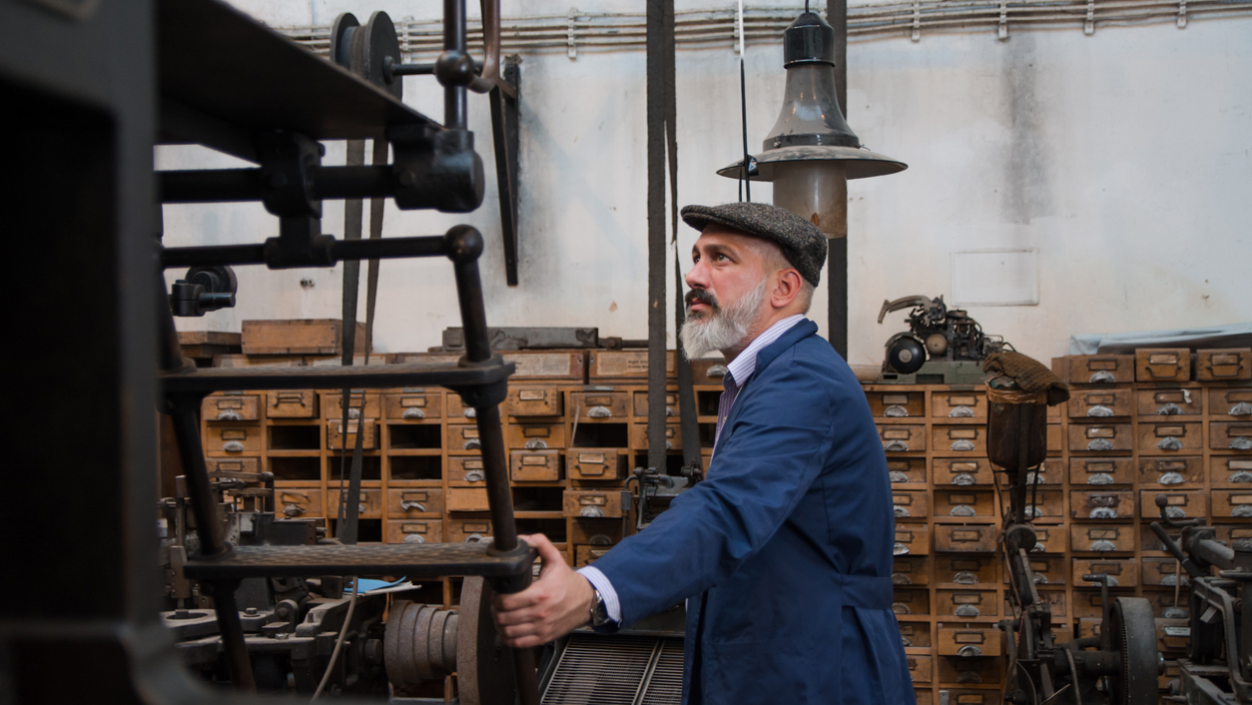Linotype Technicians and Asbestos Exposure
The Mergenthaler Linotype was a printing machine that used hot metal typesetting within a molten metal crucible. Because of the extreme heat, workers and technicians lined the Linotype with asbestos cement. Linotype technicians also wore heat-protective gear, such as asbestos gloves and aprons.

How Were Linotype Technicians Exposed to Asbestos?
In the late 19th century, the Linotype was a significant leap above existing printing technology that produced an entire line of text at one time. At the time, printers could print only single letters or words. The printing industry adopted linotypes as the gold standard for efficient printing throughout the first half of the 20th century.
Printing companies employed technicians and mechanical crews to keep Linotype machines running smoothly. Technicians were responsible for routine maintenance, such as adjusting temperature settings and advanced repairs on malfunctioning parts. Linotype workers also wore protective clothing and gear made with heat-resistant asbestos.
Linotypes contained asbestos insulation to prevent the internal parts from overheating. During repairs, technicians could easily disturb and potentially inhale the carcinogenic fibers, leading to an elevated asbestos exposure risk and the development of mesothelioma. The danger was made worse in workspaces with asbestos-containing building materials and poor ventilation.
The most common hazard occurred when technicians repaired Linotype crucibles. They would chip off the existing asbestos cement, place wet asbestos into a basin, knead it into a dough and pack the mixture into the jacket and liner before replacing the crucible.
These tasks often left asbestos residue on the equipment. Even when the technician was not working directly with asbestos, they still faced occupational exposure risks. When asbestos dust covered a machine, simply wiping soot from the gas burners or tightening the bearings became hazardous.

Get help finding a top attorney who can get you the compensation you deserve.
Get Help NowAsbestos Products Associated with Linotype Workers
Linotype manufacturers used different heat-resistant asbestos materials to protect the searing metal parts inside the machine. Technicians may also have used asbestos products to protect company property, or themselves, from burns.
- Asbestos Cement
Asbestos cement insulated the linotype crucible, the pot of molten lead located directly near the pump well, which required heat to function. In some cases, workers packed raw asbestos fibers around the crucibles.
- Asbestos Insulation
Insulation products help stabilize temperatures within sensitive machinery. Asbestos-contaminated insulation was also present in the walls and attics of many linotype workspaces.
- Asbestos Flooring
Vinyl flooring often contained asbestos for its heat-resistant properties. Over time, degraded tiles can release toxic asbestos fibers into the air.
- Spray-On Products
Asbestos-containing spray-on products were convenient for applying layers of insulation and heat protection quickly.
- Protective Gear
Linotype operators and technicians often wore protective gear, such as gloves and aprons, made with heat-resistant asbestos-treated fabrics.
Manufacturers of Products Linotype Technicians Used
Manufacturers who produced linotypes with asbestos products include:
- Mergenthaler Linotype Company: Founded in 1890, the Mergenthaler Linotype Company developed the first Linotype machine and, since 1972, has defended itself in dozens of asbestos lawsuits. There are ten ongoing asbestos cases against Mergenthaler as of 2019.
- Linotype and Machinery Company: Linotype and Machinery Company initially imported American-built machines from the Mergenthaler Linotype Company. Established in 1897 in Broadheath, England, the company’s factory helped fuel a newspaper revolution until the 1960s when computers began to gain popularity.
Other linotype manufacturers sourced their products from multiple corporations, including:
- Anchor Packing Company: Also branded as Target Gasket Sheet and Tauril Sheet Packing, Anchor Packing produced linotype products.
- Garlock Sealing Technologies: Garlock manufactured asbestos-lined gaskets for linotypes and filed for bankruptcy in 2010 after litigation.
- United States Rubber Company: Established in the 1800s, this manufacturer used asbestos to produce products between 1941 and 1976.
Linotype Workers and Mesothelioma
According to a 2022 report by the European Commission, over 70,000 workers died in 2019 from past exposure to asbestos.
A 2020 research study examined the effects of occupational asbestos exposure and the risk of lung cancer. The report estimated that occupational lung cancer is responsible for 17% to 29% of all lung cancer deaths in men.
Additionally, asbestos is the most significant occupational carcinogen accounting for around 55% to 85% of all occupational lung cancer cases. Linotype operators and other industrial workers exposed to asbestos daily rank among the highest-risk professions for asbestos-related diseases.
One 1972 study found a significant excess of lung cancer fatalities among newspaper room workers in Manchester. The increase was especially notable in machine room workers, whose responsibilities may have included linotype repairs. Linotype workers affected by asbestos exposure and experiencing symptoms can seek a mesothelioma specialist for treatment.

We have more than 50 years of combined experience helping mesothelioma patients.
Chat NowLegal Options for Linotype Technicians Exposed to Asbestos
One asbestos case involved David Peterson, who worked as a printing manager at eight different printing and publishing companies throughout his career.
His job routinely required him to service linotype machines and printing presses. After his diagnosis with an asbestos-related disease, the courts awarded Peterson damages from nine manufacturers using asbestos in products.
In another case, a former linotype worker developed a rapidly advancing mesothelioma diagnosis. He named Mergenthaler Linotype Company and several individual asbestos product manufacturers in a lawsuit as contributors to his exposure.
Linotype workers who develop asbestos-related diseases have legal options available to them. Speaking with an experienced mesothelioma lawyer can help workers discover the legal rights they have for financial compensation.
Recommended Reading


